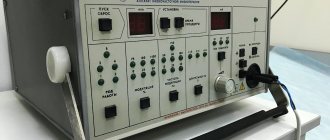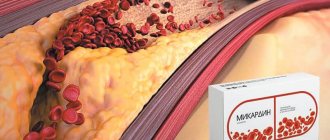Pharmacodynamics and pharmacokinetics
about dimethyl sulfoxide , what it is and exactly how it works, to understand the effect of the drug. This product is abbreviated as DMSO . It is a colorless liquid that is a bipolar aprotic solvent.
The active ingredient of the drug Dimethyl sulfoxide penetrates biological membranes. It has anti-inflammatory , antiseptic , analgesic and fibrinolytic effects. It has a transporting ability, which manifests itself through increased penetration of drugs through the skin and mucous membranes.
The mechanism of action of this drug is revealed through the inactivation of hydroxyl radicals. It helps in improving metabolism at the site of inflammation, and also reduces the speed of excitatory impulses in peripheral neurons .
When dimethyl sulfoxide it is detected in the blood after about 5 minutes. The maximum concentration of the active component is recorded after approximately 4-6 hours. At the same time, it remains at an almost unchanged level for 1.5-3 days. is metabolized to some extent in the liver. Excreted in urine and feces.
DIMETHYLSULPHOXIDE
DIMETHYLSULPHOXIDE (DMSO) (CH3)2SO, mol. m. 78.13; hygroscopic liquid, colorless and odorless; m.p. 18.45°C (easily supercooled), bp. 189°C (dec.). 83°C/17 mm Hg. Art.; d425 1.0960; nD20 1.4795; m 13.03.10-36 Kl.m; h 2.473 kPa.s (20 °C); e 48.9 (20 °C; r 0.33.108 Ohm.cm; DH0sp 57.28 kJ/mol. Dissolved in water, ethanol, acetone, diethyl ether, CbH6, CHCl3. Above 150°C, dimethyl sulfoxide slowly decomposes into ( CH3)2S and (CH3)2SO2 (electrochemical agents catalyze decomposition; in the presence of RCOCl, the reaction may be accompanied by an explosion). Oxidizes thiols into disulfides, some sulfides into sulfoxides. In the presence of catalysts (e.g., strong acids) -t and their pyridinium salts, O2, HaI2) oxidizes primary alcohols and their tosylates, primary alkyl bromides and iodides into aldehydes, oxidizes secondary alcohols to ketones, ketones and ketenimides - to a-hydroxycarbonate compounds and their amides, respectively, oxiranes into the presence of etherate BF3 - into a-hydroxyketones. With CH3I it forms trimethylsulfoxonium iodide (CH3)3S+(O).I-, with NaH, KH and tert-C4H9OK - salts of megilsulfinylcarbanion CH3S(O)CH2M+, where M is Na or K. B solutions with 1,3-dienes serves as a mild dienophile. Dimethyl sulfoxide is oxidized to (CH3)2SO2 under the action of concentrated HNO3 (when heated), Cl2 (in water), H2O2 and other strong oxidizing agents. Dimethyl sulfoxide solvates hydroxo compounds, CH- acids, org. and non-org. cations, due to which it greatly increases the speed of multiplication. districts. Dissolves well. org. and non-org. connections. Thus, pH value at 25 °C (g per 100 g): (CH3COO)2Hg - 100, SnCl2.2H2O - 40, ZnCl2 - 30, FeCl3.6H2O - 30, NaI - 30, NaNO3 - 20. Dimethyl sulfoxide is obtained by oxidation (CH3)2S oxygen in the presence of air. catalytic number of nitrogen oxides or other compounds. — O2 transporters. It is also formed during the oxidation of (CH3)2S with nitrogen oxides, H2O2 solutions upon cooling, and hydrolysis of (CH3)2SCl2, (CH3)2SBr2. Dimethyl sulfoxide is a widely used solvent (for example, for acetylene, SO2, polyacrylonitrile, etc.), a cosmetic component. and lek. sr-v (it promotes penetration through the skin of various substances). Mixtures of dimethyl sulfoxide with water - antifreeze and hydraulic. liquids. Dimethyl sulfoxide is low toxic: LD50 approx. 20 g/kg (mice, intraperitoneal). T. vsp. 95 °C. === Use. literature for the article “DIMETHYLSULPHOXIDE” : UAE S., Chemistry of organic sulfur compounds, trans.
from Japanese, M., 1975, p. 223-78. A. F. Kolomiets. N. D. Chkanikov. The page “DIMETHYLSULPHOXIDE” was prepared based on materials from the chemical encyclopedia.
More on the topic:
- Dimethyl sulfoxide - a guide to substances
Indications for use
Dimethyl sulfoxide is used in the case of inflammatory diseases of the musculoskeletal system, traumatic infiltrates , purulent wounds, osteomyelitis , streptoderma , bruises, inflammatory edema , abscesses , erythema nodosum .
In addition, it can be prescribed for combination with NSAIDs for the treatment of deforming osteoarthritis and rheumatoid arthritis , with Heparin in the case of thrombophlebitis , as well as with local antimicrobial scleroderma , erysipelas , eczema , acne , furunculosis , trophic ulcers . The product is also used in skin plastic surgery to preserve skin homografts
Instructions for use of Dimethyl sulfoxide (Method and dosage)
The instructions for Dimethyl sulfoxide indicate that it is used, as a rule, in the form of aqueous solutions (approximately 50% concentration) for compresses, rinsing and tampons. Gauze is moistened with the solution and applied to the affected areas, as well as adjacent areas. Next, a plastic film and cotton or linen fabric are applied.
In the case of trophic ulcers and erysipelas, the medicine is used in the form of a solution (30-50%) 2-3 times a day in a dosage of 50-100 ml. Instructions for use for eczema and diffuse streptoderma recommend making compresses with a solution (40-90%). For furunculosis, a 40% solution is used. For local anesthesia, take a solution (25-50%) and make compresses 2-3 times a day in a dosage of 100-150 ml. In case of deep burns , apply bandages with a 20-30% solution. If it is necessary to wash purulent-necrotic wounds and areas of inflammation, a 10-30% solution is used.
Dimethyl sulfoxide solution 20-30% is also used in skin plastic surgery for auto- and homografts . Bandages are applied immediately after surgery and on the first day before the graft engrafts.
Additionally, a 5% solution in Ringer's solution is used as a preservation medium for skin homografts .
Dimexide
Dosage form
Concentrate for preparing a solution for external use.
Compound
Dimethyl sulfoxide – 50, 100 ml
Description
Colorless transparent liquid or colorless crystals, odorless or with a weak specific odor. Hygroscopic.
Pharmacotherapeutic group
Anti-inflammatory agent for topical use
ATX code: M02AH0Z
Pharmacological properties
Pharmacodynamics
Anti-inflammatory drug for external use, inactivates hydroxyl radicals, improves the course of metabolic processes in the site of inflammation. It also has local anesthetic, analgesic and antimicrobial effects; has moderate fibrinolytic activity. Penetrates through the skin, mucous membranes, the membrane of microbial cells (increases their sensitivity to antibiotics) and other biological membranes, increases their permeability to drugs.
Pharmacokinetics
When a solution of dimethyl sulfoxide is applied to the skin, it is detected in the blood after 5 minutes, reaching its maximum concentration after 4-6 hours, maintaining an almost unchanged level for 1.5-3 days. Dimethyl sulfoxide is excreted in urine and feces, both unchanged and in the form of dimethyl sulfone.
Indications for use
As part of complex therapy: diseases of the musculoskeletal system: rheumatoid arthritis, ankylosing spondylitis (ankylosing spondylitis), deforming osteoarthritis (in the presence of damage to periarticular tissues), reactive synovitis; limited scleroderma, erythema nodosum, discoid lupus erythematosus, mycoses of the feet, keloid scars, thrombophlebitis, alopecia, eczema, streptoderma, erysipelas, bruises, sprains, traumatic infiltrates, purulent wounds, burns, radiculitis, trophic ulcers, acne, furunculosis; in skin plastic surgery – preservation of skin homografts.
Contraindications
Hypersensitivity, severe hepatic and/or renal failure, angina pectoris, severe atherosclerosis, glaucoma, cataracts, stroke, coma, myocardial infarction, pregnancy, breastfeeding. Do not administer to children under twelve years of age.
Use during pregnancy and breastfeeding
Use during pregnancy and breastfeeding is contraindicated.
Directions for use and doses
Externally, in the form of applications and irrigations (washes). Gauze wipes are moistened in a solution of the required concentration and applied to the affected areas for 20-30 minutes. A plastic film and cotton or linen cloth are placed on top of the napkin. The duration of applications is 10-15 days.
When treating erysipelas and trophic ulcers - in the form of a 30-50% solution in water, 50-100 ml 2-3 times a day.
For eczema, streptoderma - compresses with a 40-90% solution in water.
For local anesthesia for pain syndromes - a 25-50% solution in water in the form of compresses of 100-150 ml (depending on the area being treated) 2-3 times a day.
For facial skin and other highly sensitive areas, use 10-20-30% solutions in water.
In skin plastic surgery, a 5% solution in Ringer's solution is used as a preservative medium for storing skin homografts.
Purulent-necrotic and inflammatory foci and cavities are washed with less concentrated solutions.
Side effect
Allergic reactions, contact dermatitis, erythematous rashes, dry skin, mild burning, itchy dermatitis; rarely – bronchospasm.
Overdose
Symptoms: increased dose-dependent side effects. Treatment is symptomatic.
Interaction with other drugs
Increases absorption and enhances the effect of ethanol, insulin and other drugs. Compatible with heparin, antibacterial drugs, non-steroidal anti-inflammatory drugs. Increases the sensitivity of microorganisms to aminoglycoside and beta-lactam antibiotics; chloramphenicol, rifampicin, griseofulvin. Sensitizes the body to drugs for general anesthesia.
special instructions
Some patients smell garlic in the air they breathe. Before using the drug, it is necessary to test for tolerance to it. To do this, dimethyl sulfoxide of the required concentration is applied to the skin using a cotton swab soaked in it; the appearance of hyperemia and severe itching indicates hypersensitivity.
When stored at a temperature of 18 °C and below, crystallization of dimethyl sulfoxide occurs, which does not affect the quality of the drug. To melt the crystals, carefully heat the bottle with the drug in a water bath (water temperature no higher than 60 ° C).
Impact on the ability to drive vehicles and machinery
The use of the drug does not affect the ability to perform potentially hazardous activities that require increased concentration, special attention and speed of psychomotor reactions (driving vehicles, working with moving mechanisms, working as a dispatcher and operator).
Release form
Concentrate for preparing a solution for external use 99%.
50, 100 ml in orange glass bottles with a screw neck, sealed with polyethylene stoppers and screw caps. Each bottle with instructions for use is placed in a cardboard pack.
Best before date
2 years. Do not use after the expiration date.
Storage conditions
In a dry place, protected from light, at a temperature not exceeding 25 ° C.
Keep out of the reach of children.
Vacation conditions
Dispensed by prescription.
Interaction
The medicine increases the degree of absorption and enhances the effect of other drugs. It can be used in conjunction with Heparin , as well as non-steroidal anti-inflammatory and antibacterial agents. In addition, this drug increases sensitivity to beta-lactam and aminoglycoside antibiotics , Rifampicin , chloramphenicol , Griseofulvin .







